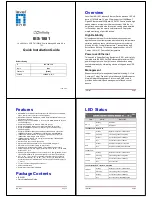
VLANs and Port Tagging
To add an interface to a VLAN, the interface must be in Layer 2 mode. After you place an interface in Layer 2 mode, the interface is
automatically placed in the Default VLAN.
Dell Networking OS supports IEEE 802.1Q tagging at the interface level to filter traffic. When you enable tagging, a tag header is added to
the frame after the destination and source MAC addresses. That information is preserved as the frame moves through the network. The
following example shows the structure of a frame with a tag header. The VLAN ID is inserted in the tag header.
Figure 121. Tagged Frame Format
The tag header contains some key information that Dell Networking OS uses:
•
The VLAN protocol identifier identifies the frame as tagged according to the IEEE 802.1Q specifications (2 bytes).
•
Tag control information (TCI) includes the VLAN ID (2 bytes total). The VLAN ID can have 4,096 values, but two are reserved.
NOTE:
The insertion of the tag header into the Ethernet frame increases the size of the frame to more than the 1,518 bytes as
specified in the IEEE 802.3 standard. Some devices that are not compliant with IEEE 802.3 may not support the larger frame
size.
Information contained in the tag header allows the system to prioritize traffic and to forward information to ports associated with a specific
VLAN ID. Tagged interfaces can belong to multiple VLANs, while untagged interfaces can belong only to one VLAN.
Configuration Task List
This section contains the following VLAN configuration tasks.
•
(mandatory)
•
Assigning Interfaces to a VLAN
(optional)
•
Assigning an IP Address to a VLAN
(optional)
•
Enabling Null VLAN as the Default VLAN
Creating a Port-Based VLAN
To configure a port-based VLAN, create the VLAN and then add physical interfaces or port channel (LAG) interfaces to the VLAN.
NOTE:
The Default VLAN (VLAN 1) is part of the system startup configuration and does not require
configuration.
A VLAN is active only if the VLAN contains interfaces and those interfaces are operationally up. As shown in the following example, VLAN 1
is inactive because it does not contain any interfaces. The other VLANs contain enabled interfaces and are active.
NOTE:
In a VLAN, the
shutdown
command stops Layer 3 (routed) traffic only. Layer 2 traffic continues to pass through the
VLAN. If the VLAN is not a routed VLAN (that is, configured with an IP address), the
shutdown
command has no affect on
VLAN traffic.
When you delete a VLAN (using the
no interface vlan
vlan-id
command), any interfaces assigned to that VLAN are assigned to
the Default VLAN as untagged interfaces.
To create a port-based VLAN, use the following command.
Virtual LANs (VLANs)
873
Summary of Contents for S3048-ON
Page 1: ...Dell Configuration Guide for the S3048 ON System 9 11 2 5 ...
Page 137: ...0 Gi 1 1 Gi 1 2 rx Flow N A N A 0 0 No N A N A yes Access Control Lists ACLs 137 ...
Page 142: ...Figure 10 BFD Three Way Handshake State Changes 142 Bidirectional Forwarding Detection BFD ...
Page 241: ...Dell Control Plane Policing CoPP 241 ...
Page 287: ... RPM Synchronization GARP VLAN Registration Protocol GVRP 287 ...
Page 428: ...Figure 53 Inspecting the LAG Configuration 428 Link Aggregation Control Protocol LACP ...
Page 477: ...Figure 73 Configuring Interfaces for MSDP Multicast Source Discovery Protocol MSDP 477 ...
Page 478: ...Figure 74 Configuring OSPF and BGP for MSDP 478 Multicast Source Discovery Protocol MSDP ...
Page 483: ...Figure 77 MSDP Default Peer Scenario 2 Multicast Source Discovery Protocol MSDP 483 ...
Page 484: ...Figure 78 MSDP Default Peer Scenario 3 484 Multicast Source Discovery Protocol MSDP ...
Page 745: ...Figure 104 Single and Double Tag TPID Match Service Provider Bridging 745 ...
Page 746: ...Figure 105 Single and Double Tag First byte TPID Match 746 Service Provider Bridging ...
















































